Future of Lycoming Engines in Government Aviation: Challenges and Innovations
Lycoming Engines owns the majority market share of the piston aircraft engine and powers about half of the world’s piston engine aircraft. And owns the largest fleet of Lycoming-powered aircraft in the world? The United States Federal Government. The Civil Air Patrol owns approximately 560 piston-engined airplanes, which primarily operate Lycoming engines. The CAP is the biggest user, but several other agencies fly hundreds of piston-powered airplanes.
With so many advances focused on electronics and also turbine engines, what is the future of Lycoming engines in government use? At their core, these engines have remained largely unchanged for nearly a century. Sure, electronic ignition and electronic fuel injection have made them much more reliable, but an air-cooled flat engine is still an air-cooled flat engine.
Here is how the market is changing for federal customers, and how Greenwood Aerospace is meeting the demand.
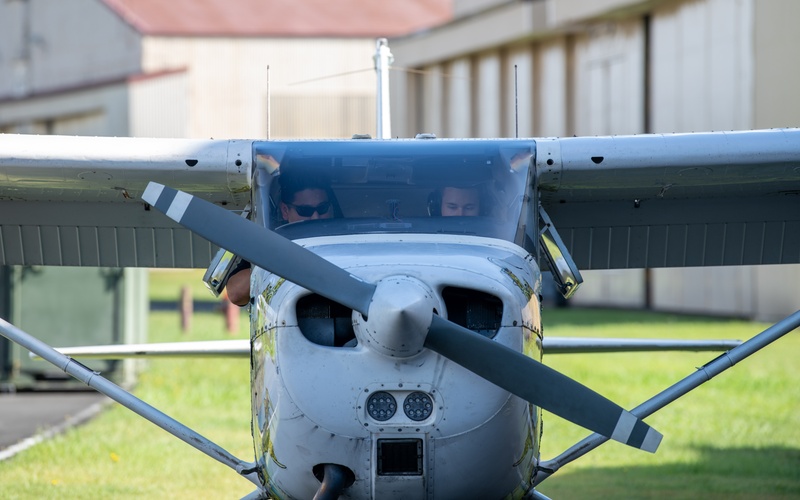
The Government’s Reliance on Lycoming Engines
The government relies on thousands upon thousands of vendors and manufacturers for millions of products. Major manufacturers, such as John Deere and Caterpillar, have billions of dollars in contracts with the U.S. government to provide heavy machinery and construction equipment. Relying on Lycoming for aircraft engines is no different; the government does not have a say in which engines are used in commercial off-the-shelf aircraft, such as Cessnas and Pipers, that it routinely purchases and operates.
The government only has a say in engine selection when it requests a unique aircraft design of its own, like the next generation of Air Force training aircraft.
Most, if not all, Cessna piston-powered aircraft made since the beginning of the 21st Century were made with Lycoming engines, and these are the most prolific aircraft owned by the U.S. government. Almost the entire CAP fleet consists of Cessnas, and most of the FBI's fleet (what we know of it, anyway) is also made up of Cessnas.
Almost all modern Cessnas are powered by Lycoming engines, so when you buy a newer Cessna, odds are good that it has a Lycoming engine in it.
What aircraft use Lycoming engines?
The majority of the Civil Air Patrol fleet is Cessna 182 Skylanes. With over 300 examples in their fleet, it dwarfs all other models. The Cessna 182 Skylane and 182T, the turbo-charged variant, each use a version of the Lycoming IO-540 engine. The IO-540 is a fuel-injected six-cylinder horizontally opposed engine that has a 540 cubic inch displacement. The Cessna 182 operates the Lycoming IO-540-AB1A5, rated at 230 horsepower. This engine is mated with either a two-blade or three-blade variable pitch propeller.
The Cessna 172 Skyhawk is the most manufactured aircraft of all time, and it is the second-most widely used Cessna in government service, mainly with the CAP. Still, the Air Force Academy also uses it for primary cadet flight familiarization.
The Cessna 172 is an excellent airplane that almost all pilots began their careers flying, for one reason or another; however, it is not truly a four-seat airplane in the sense of the word. Yes, it has four seats, but you cannot really fill it with fuel, passengers, and luggage. With full fuel and luggage, it is realistically a two-person aircraft, especially when operating at high-density altitudes. However, the Skyhawk remains the second-most widely used aircraft in the CAP fleet, and there are likely a few examples in use by other federal agencies.
For this reason, the CAP operates the Cessna 182 for the majority of aerial operations. It can operate easily at most airport elevations nationwide, especially the 182T turbocharged models. The Cessna 206 is overkill for most missions, and the Cessna 182 is a more cost-effective option. Operators in the government will have reduced fuel consumption and overall fuel savings since the Cessna 182, while using the same core engine model.
Fuel burn is reduced through technological improvements in engine technology over the years, particularly in the improved fuel-air delivery method. Fuel injection has not only increased reliability but also increased fuel efficiency. Yes, it does increase the overall complexity of the engine, but the fuel burn reduction and increased power make this an easy tradeoff.
Long Blocks versus Short Blocks
Aircraft engines are shipped as a long block, meaning that the engine consists of the case, the crankshaft, and cylinder head assemblies, along with other components like the camshaft and valves. All of the exhaust, intake, fuel supply, and electronics come off of your old engine and are installed when the new (or factory rebuilt) engine is installed.
So, the phrase ‘new engine’ is a misnomer; the block is new or factory remanufactured, but the only new part of the engine is the block. The technology used is not advanced at all from the old block, so you will still have the exact same engine configuration with the new engine that you had before; you will just have a new block with zero hours.
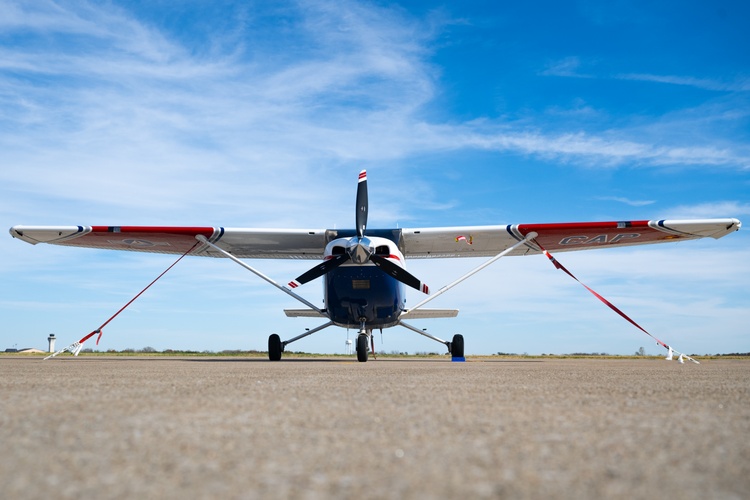
Current Procurement Challenges
The biggest challenge currently faced by Lycoming procurement is the long lead times associated with getting an engine. While all cases or long blocks are different, some lead times can be as long as two years.
The challenge with this is timing your purchase correctly. You have to wait until you have funds available for that particular fiscal year, and also make sure that you are not too far out on the engine purchase to be approved. Also, since Lycoming recommends engines be overhauled every 12 years regardless of hours, the clock is ticking the day you receive your new engine. Buying early and letting it sit around for a year or two just ticks time off the clock, effectively taking hours away from the new engines.
So, the biggest challenge with procurement is juggling these three things: timing (Lycoming lead time), timing (hours remaining on TBO), and money. The last thing you need is to have problems with the procurement process itself, which is where Greenwood Aerospace steps up to help you. We have partnered with Lycoming engines to be your preferred procurement agent. We can source the most popular new and factory remanufactured engines in the Lycoming catalog.
What is the FAA AD for Lycoming engines?
This is a question that comes up fairly often, and it is not a simple answer. Like all engine manufacturers and airplane manufacturers, there are lots of ADs spanning the years and spanning all of the different engine models.
The FAA has issued multiple Airworthiness Directives (ADs) for Lycoming engines addressing connecting rod bushing degradation, crankshaft failures, and oil inspections. AD 2024-21-02, for example, requires inspecting connecting rod bushings for damage and wear, and replacement if necessary. Other ADs address specific engine models and components, such as crankshaft assemblies. Compliance is mandatory for continued airworthiness.
Here’s a breakdown:
- AD 2024-21-02:
This AD, issued October 31, 2024, affects Lycoming engines with specific connecting rod assemblies and bushings. It requires enhanced oil inspections to detect bronze metal particulates, which indicate wear on the bushing. If particulates are found, additional inspections of the bushings are required, and they must be replaced if damaged or worn. - Crankshaft Failures:
Some ADs address crankshaft failures, especially those related to Superior Air Parts (SAP) crankshafts. These ADs require the removal of specific crankshaft assemblies to prevent engine power loss and accidents. - Other ADs:
The FAA has issued many other ADs for Lycoming engines addressing various issues. These may include specific engine models, components, or manufacturing dates. According to the AOPA, an emergency AD was issued in 2017 for Lycoming small end bushings. - Compliance:
Compliance with these Airworthiness Directives (ADs) is mandatory for continued airworthiness. Aircraft owners and operators are responsible for ensuring their aircraft is compliant with all applicable ADs. - Resources:
The FAA’s website, Federal Register (.gov), and the FAA’s Dynamic Regulatory System are the primary sources for AD information.
What is the failure rate of Lycoming engines?
Nobody wants to think about this, but it is a reality: all engines can fail and eventually will fail. The mean time between failure of a Lycoming aircraft engine is far longer than that of an average automobile engine, but much, much more common than jet and turbine engine failures.
One study indicated that less than one engine out of every 1,000 Lycoming engines being tracked would have an engine failure. These are pretty good odds. Another analysis put this at one failure for every 3,200 flight hours in piston engines (the brand was not specified).
Lycoming has a slight advantage in fleet size over the nearest competitor, Continental, but their failure rates are very close. Comparable failure rates and reliability metrics are primarily attributed to the extremely strict and rigid maintenance requirements imposed by the FAA and their foreign counterparts on all general aviation aircraft.
Innovations in Lycoming Engine Technology
The basic air-cooled, horizontally-opposed aircraft engine design has changed very little over the past century. An IO-360 is still basically the same engine that it was 50 years ago. Yes, there have been upgrades in fuel and air delivery and ignition, but the core engine has been around since 1952.
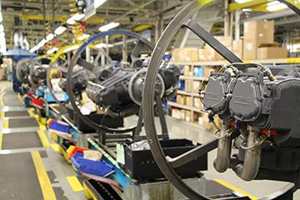
With that said, if you do not innovate, you die.
Lycoming has been busy over the years with a few innovative products, although these are designed mainly for high-performance engines, rather than run-of-the-mill fleet aircraft.
Lycoming’s legacy engines are also continually innovating. However, it is a little less dramatic than their iE2 series of engines and their high-performance Thunderbolt custom builds (used almost exclusively for unlimited aerobatics aircraft).
The Legacy engines are a series of ongoing process improvements made over six or seven decades, possibly even more for some models. Manufacturing processes have improved over the generations since these engines started gracing the skies, making them arguably more efficient, more powerful, and overall better aircraft. The innovative focus by Lycoming is instead on reliability, long TBO cycles, and incremental improvements. It is the veritable tortoise versus hare. Why sprint when the brand was built on the long view? Lycoming engines are proven designs with thousands of engines in service.
Besides, performance always comes at a cost. High-performance engines are always more finicky, require more maintenance, and usually have shorter intervals between major repairs or overhauls. For government fleet aircraft, the goal is an engine that is predictable and unwaveringly reliable. When you are flying SAR missions with the CAP, or drug interdictions and border surveillance with the CBP, you are not looking for extreme torque and horsepower; you need to know that you can reliably go from Point A, loiter, and return to Point A or B without a problem.
That’s exactly what Lycoming has worked hard on with its Legacy engines for years.
What is the TBO on a Lycoming engine?
The TBO is not necessarily a hard line in the sand where you have to stop flying. However, habitually crossing that line is not a good practice, especially when you are managing a fleet of aircraft.
The TBO varies between each engine model, and even sub-models can vary. The guide for these figures can be found in Lycoming Service Instruction No. 1009BE. Here is a brief rundown on common interval cycles:
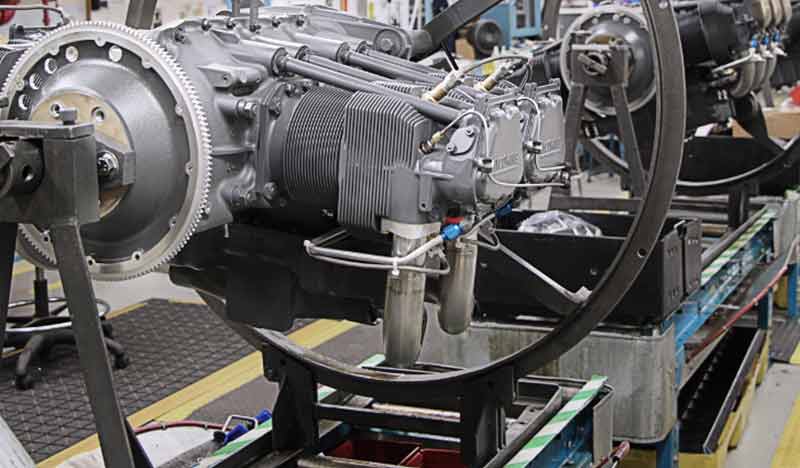
The Time Between Overhaul (TBO) intervals for Lycoming’s most common engine models vary depending on the specific model, configuration, and whether the engine is used in fixed-wing or rotary-wing aircraft. Here is a summary of the typical TBO recommendations, with supporting links to Lycoming’s official documentation:
Common Lycoming Engine TBO Intervals
- O-320 Series (e.g., O-320-B, O-320-D):
- Typical TBO: 2,000 hours for most models with large main bearing dowels and redesigned camshafts, as specified in Lycoming Service Instruction 1009.
- Older or non-upgraded engines: 1,200–1,400 hours, depending on configuration.
- Typical TBO: 2,000 hours for most models with large main bearing dowels and redesigned camshafts, as specified in Lycoming Service Instruction 1009.
- O-360 Series (e.g., O-360-A, O-360-C):
- Typical TBO: 2,000 hours for models with large main bearing dowels and redesigned camshafts
- Non-upgraded engines: 1,200–1,400 hours.
- Typical TBO: 2,000 hours for models with large main bearing dowels and redesigned camshafts

- IO-360 Series (e.g., IO-360-A, IO-360-C):
- Typical TBO: 2,000 hours for upgraded models
- Typical TBO: 2,000 hours for upgraded models
- O-540 Series (e.g., O-540-A, O-540-J):
- Typical TBO: 2,000 hours for most models with required upgrades.
- Non-upgraded or certain agricultural/chemical application engines: 1,200–1,500 hours.
- Typical TBO: 2,000 hours for most models with required upgrades.
- IO-540 Series (e.g., IO-540-C, IO-540-V):
- Typical TBO: 2,000 hours for most models with required upgrades.
- Agricultural or chemical application engines: Maximum 1,500 hours, or as specified in Table 1 of SI 1009BE, whichever is lower.
- Typical TBO: 2,000 hours for most models with required upgrades.
Calendar TBO
- All Lycoming Engines: 12 calendar years, regardless of hours.
TBO Extensions
- 200-Hour Extension: Available for Lycoming Factory New, Rebuilt, and Overhauled engines, as well as field overhauls that meet Lycoming’s requirements.
- Combined Extensions: In some cases, up to 400 hours of TBO extension may be approved if multiple notes in SI 1009BE apply.
Supporting Documentation and Links
- Lycoming Service Instruction 1009BE (TBO Schedules):
Lycoming SI 1009BE (PDF)
Lycoming SI 1009BE (Webpage)
Lycoming TBO Extensions Announcement - NTSB Archive of Lycoming TBO Documents:
NTSB TBO Document 1 (PDF)
NTSB TBO Document 2 (PDF)
Lycoming Overhaul Schedule Summary Table
Engine Series
Typical TBO (Hours)
Notes / Conditions
O-320
1,200–2,000
Upgraded models: 2,000
O-360
1,200–2,000
Upgraded models: 2,000
IO-360
1,200–2,000
Upgraded models: 2,000
O-540
1,200–2,000
Upgraded models: 2,000
IO-540
1,200–2,000
Upgraded models: 2,000
All Engines
12 years
Calendar TBO, regardless of hours
For exact TBO values, always refer to Lycoming Service Instruction 1009BE and your specific engine’s configuration and history.
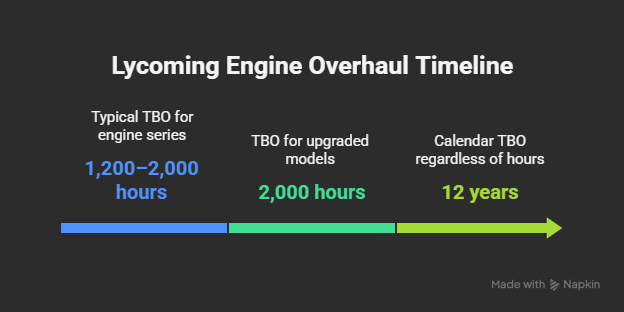
The Importance of Proactive Engine Procurement
Staying ahead of the curve in engine procurement is extremely important because there is a well-known lead time associated with buying new and factory remanufactured engines. We touched on this topic in an earlier article because it is essential to understand why there is a lead time and why it is unlikely to change soon.
Lycoming is behind on engine production, but it is hard to justify expanding their production if the demand does not correlate after they have caught up with current demand. There are only so many Lycoming-powered aircraft being built and currently flying, so a large capital investment in increased production might help in the short term, but it would be a bad business decision in the long term.
What Is the Meaning of Government Procurement?
Government procurement is the process by which governments purchase goods and services. It is a complex process involving various stakeholders, including government agencies, contractors, and the public.
Government procurement can be divided into two main categories:
- Public procurement
- Government contracting
Public procurement is the process by which governments purchase goods and services for the general public. Government contracting is the process by which governments purchase goods and services for specific government programs or projects.
There are several types of government contracts, including fixed-price contracts, cost-reimbursement contracts, time-and-materials contracts, incentive contracts, and indefinite-delivery and quantity contracts.
How Greenwood Aerospace Supports Government Aviation
Greenwood Aerospace has been in the business of supporting government aviation for over forty years. We are an authorized distributor of Lycoming engines, both new and factory remanufactured, and are dedicated to helping you get the best deal possible on a factory replacement Lycoming engine for your aircraft.
Over the years, we have worked with many aviation units across the federal government, from the branches of the military to NOAA, the FAA, and more. Greenwood Aerospace is an AS9120 B-accredited company dedicated to constantly meeting customer satisfaction. We do this through superior product quality, timeliness, and unmatched customer service.
Greenwood Aerospace is registered in the System for Award Management (SAM), which allows us to be identified by contracting officers as eligible to receive HUBZone contracts.
Greenwood Aerospace is a U.S. Department of State ITAR-registered company, enabling us to partner with large defense contractors on various military initiatives involving the export of ITAR-controlled items.
- UEI: KVSUYYSJS174
- DUNS: 604006874
- Cage Code: 2Y735
- ITAR DDTC Export Compliant
- AS9120B QMS Certified
- NAICS: 488190, 336413, 332722, 336411, 336413, 481212, 532411

.webp)
.svg)





